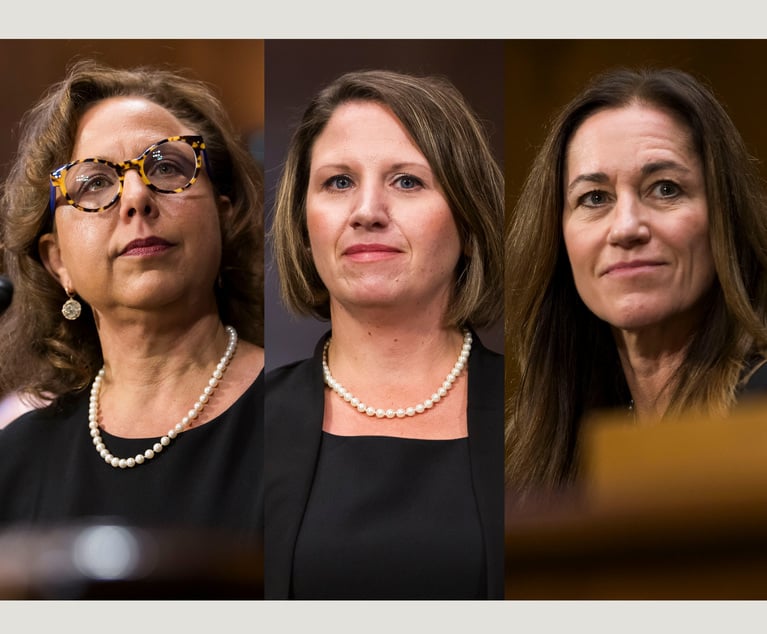 Sid Steinberg of Post & Schell
Sid Steinberg of Post & SchellRecent NLRB Decision Reminds Employers of the Need for Consistency
If there is one theme of this column over the years, it is that employers must be both credible and consistent in their explanation for employment decisions. One without the other is helpful, but both are necessary for an employer to prevail.
June 11, 2019 at 01:34 PM
6 minute read
If there is one theme of this column over the years, it is that employers must be both credible and consistent in their explanation for employment decisions. One without the other is helpful, but both are necessary for an employer to prevail. While we see this issue raised most often in the context of summary judgment or trial decisions in court, a recent decision of the National Labor Relations Board reinforces the point. The decision in MCPc and Jason Galanter, Case no. 06-CA-063690 (May 23) also serves to remind nonunion employers that all employees are entitled to the protections of the National Labor Relations Act when it comes to retaliation for “protected concerted activity”—which is usually speaking up on behalf of co-workers over the terms and conditions of employment.
|Complaint of Excessive Work Is 'Protected Activity' Under the NLRA
Jason Galanter was an engineer working for MCPc, an IT support company headquartered in Cleveland, Ohio. Galanter worked in the company's Pittsburgh office when he was invited to a “team building” lunch with the director of engineering, Dominick DelBalso. During the lunch, Galanter raised concerns about his co-workers' heavy workloads and urged DelBalso to hire additional engineers. He also stated that the company could have hired additional engineers for the $400,000 salary it was paying to a recently hired executive. Galanter was joined in this sentiment by a number of his co-workers.
About a week later, Galanter was directed to report to MCPc's headquarters in Cleveland, where he was met by the company's CEO and the vice president of human resources. The CEO questioned Galanter as to how he learned the salary information discussed during the previous week's lunch. Galanter, at first, denied having such knowledge and then gave multiple explanations both as to the substance of his comment and where he “may have” learned the information in question. The CEO then told Galanter that the company and he needed a “divorce” and that he was thereby terminated.
|Explanation to the Hearing Judge
Galanter filed an unfair labor practice change with the NLRB, claiming that his statements during the lunch with DelBalso were “protected concerted activity” and that his termination was retaliatory and in violation of the NLRA.
In it is initial statement to the NLRB's regional office, the company stated that “it terminated Galanter for accessing and disseminating confidential salary information” in violation of its “confidentiality policy.” The confidentiality policy states, in relevant part, that “idle gossip or dissemination of confidential information within MCPc, such as personal or financial information, etc. will subject the responsible employee to disciplinary action or possible termination.”
Significantly, the hearing judge at the region level found that the confidentiality policy, itself, was overbroad and violated the NLRA. The judge then found that MCPc violated the NLRA by discharging Galanter both for his protected concerted activity at the team-building lunch (that is, speaking for his coworkers in discussing their burdensome workloads) and because the termination was based upon an unlawful policy.
|Post-Hearing Brief Brings Explanation
After the judge's initial ruling, the company filed exceptions to his report and asserted that Galanter's discharge was “unrelated” to its confidentiality policy. Instead, it argued that Galanter was discharged because he “disclosed confidential salary information and then, during the company's investigation into his conduct, lied about where he obtained that information.”
MCPc appealed the judge's opinion to the full National Labor Relations Board, which affirmed the decision. The company then appealed the board's decision to the U.S. Court of Appeals for the Third Circuit, which agreed that Galanter had engaged in protected concerted activity “when he raised the engineer shortage at the team-building lunch.” It found, however, that the board had applied the wrong test for determining whether Galanter's discharge violated the act. Specifically, the Third Circuit held that MCPc's explanation for the termination decision should be subjected to a “mixed motive” analysis such that once the NLRB's general counsel “showed an improper motive for Galanter's discharge, the remaining question was whether Galanter would have been discharged for his misconduct or dishonestly regardless of MCPc's unlawful motivation.” The appellate court, therefore, remanded the case to the NRLB and directed that this test be applied.
|Pretextual Explanation in Any Forum
On remand, the board found that, in a test familiar to employment law practitioners, “where the record demonstrates that the employer's proffered reasons are pretextual—that is, either false or not in fact relied upon—the employer fails by definition to show that it would have taken the same action for those reasons, absent the protected conduct …” Upon consideration of the evidence, and most particularly MCPc's stated reasons for Galanter's discharge, the board found that the explanations offered were pretextual.
Specifically, as noted, until its post-hearing briefing, MCPc asserted that Galanter was terminated because he violated the company's confidentiality policy. Its post-hearing argument was, however, that Galanter's discharge was because he had improperly accessed confidential salary information but that the decision was “unrelated to its confidentiality policy.” Upon remand to the board, however, the board found that MCPc “abandoned the rationale that Galanter was discharged for improperly obtaining confidential information and asserted that its decision to terminate Galanter 'was based solely on his dishonesty.'” The company went so far as to characterize Galanter “alleged improper access to the salary information as 'the ultimate red herring.'” The board found that “the shifting rationale provided by the company supports a conclusion that the proffered reasons for Galanter's discharge—his purported dishonesty and the company's belief that he improperly accessed confidential information—are pretextual.”
The message is obvious. Employers and their counsel need to “pick a lane” the first time and stick to it. This doesn't mean that explanations for employment actions can't evolve or be given added depth, but whether it is in front of the Equal Employment Opportunity Commission (EEOC), the NLRB and most definitely by the time a case gets to court, employers and counsel need to have thought through the explanation, reviewed the policies at issue and offer an explanation that will withstand both scrutiny and the test of time.
Sid Steinberg is a principal and chair of Post & Schell's employment and employee relations and labor practice groups. Steinberg's practice involves virtually all aspects of employee relations, including litigation experience defending employers against employment discrimination in federal and state courts. He also represents employers before federal, state and local administrative agencies, and regularly advises employers in matters including employee discipline, labor relations, and the creation or revision of employee handbooks. He can be reached at [email protected].
This content has been archived. It is available through our partners, LexisNexis® and Bloomberg Law.
To view this content, please continue to their sites.
Not a Lexis Subscriber?
Subscribe Now
Not a Bloomberg Law Subscriber?
Subscribe Now
NOT FOR REPRINT
© 2024 ALM Global, LLC, All Rights Reserved. Request academic re-use from www.copyright.com. All other uses, submit a request to [email protected]. For more information visit Asset & Logo Licensing.
You Might Like
View All
Pa. Federal District Courts Reach Full Complement Following Latest Confirmation

The Defense Bar Is Feeling the Strain: Busy Med Mal Trial Schedules Might Be Phila.'s 'New Normal'
7 minute read
Federal Judge Allows Elderly Woman's Consumer Protection Suit to Proceed Against Citizens Bank
5 minute read
Judge Leaves Statute of Limitations Question in Injury Crash Suit for a Jury
4 minute readTrending Stories
- 1The Crypto Guys Seem to Like Paul Atkins as a New SEC Commissioner, but Will He Be Good for the Securities Industry?
- 2Lawsuits, AI Accuracy and Debt: Legal Tech Companies that Ran Into Trouble in 2024
- 3Preemptive Litigation: A Potential Approach for a Precise Situation
- 4Paxton's 2024 Agenda: Immigration, Climate, Transgender Issues, Social Media, Abortion, Elections
- 5Let’s Hear It One Last Time!: One More Bow for 2024’s Litigators of the Week
Who Got The Work
Michael G. Bongiorno, Andrew Scott Dulberg and Elizabeth E. Driscoll from Wilmer Cutler Pickering Hale and Dorr have stepped in to represent Symbotic Inc., an A.I.-enabled technology platform that focuses on increasing supply chain efficiency, and other defendants in a pending shareholder derivative lawsuit. The case, filed Oct. 2 in Massachusetts District Court by the Brown Law Firm on behalf of Stephen Austen, accuses certain officers and directors of misleading investors in regard to Symbotic's potential for margin growth by failing to disclose that the company was not equipped to timely deploy its systems or manage expenses through project delays. The case, assigned to U.S. District Judge Nathaniel M. Gorton, is 1:24-cv-12522, Austen v. Cohen et al.
Who Got The Work
Edmund Polubinski and Marie Killmond of Davis Polk & Wardwell have entered appearances for data platform software development company MongoDB and other defendants in a pending shareholder derivative lawsuit. The action, filed Oct. 7 in New York Southern District Court by the Brown Law Firm, accuses the company's directors and/or officers of falsely expressing confidence in the company’s restructuring of its sales incentive plan and downplaying the severity of decreases in its upfront commitments. The case is 1:24-cv-07594, Roy v. Ittycheria et al.
Who Got The Work
Amy O. Bruchs and Kurt F. Ellison of Michael Best & Friedrich have entered appearances for Epic Systems Corp. in a pending employment discrimination lawsuit. The suit was filed Sept. 7 in Wisconsin Western District Court by Levine Eisberner LLC and Siri & Glimstad on behalf of a project manager who claims that he was wrongfully terminated after applying for a religious exemption to the defendant's COVID-19 vaccine mandate. The case, assigned to U.S. Magistrate Judge Anita Marie Boor, is 3:24-cv-00630, Secker, Nathan v. Epic Systems Corporation.
Who Got The Work
David X. Sullivan, Thomas J. Finn and Gregory A. Hall from McCarter & English have entered appearances for Sunrun Installation Services in a pending civil rights lawsuit. The complaint was filed Sept. 4 in Connecticut District Court by attorney Robert M. Berke on behalf of former employee George Edward Steins, who was arrested and charged with employing an unregistered home improvement salesperson. The complaint alleges that had Sunrun informed the Connecticut Department of Consumer Protection that the plaintiff's employment had ended in 2017 and that he no longer held Sunrun's home improvement contractor license, he would not have been hit with charges, which were dismissed in May 2024. The case, assigned to U.S. District Judge Jeffrey A. Meyer, is 3:24-cv-01423, Steins v. Sunrun, Inc. et al.
Who Got The Work
Greenberg Traurig shareholder Joshua L. Raskin has entered an appearance for boohoo.com UK Ltd. in a pending patent infringement lawsuit. The suit, filed Sept. 3 in Texas Eastern District Court by Rozier Hardt McDonough on behalf of Alto Dynamics, asserts five patents related to an online shopping platform. The case, assigned to U.S. District Judge Rodney Gilstrap, is 2:24-cv-00719, Alto Dynamics, LLC v. boohoo.com UK Limited.
Featured Firms
Law Offices of Gary Martin Hays & Associates, P.C.
(470) 294-1674
Law Offices of Mark E. Salomone
(857) 444-6468
Smith & Hassler
(713) 739-1250





